For scientific photo excellence, consider Plan Apochromatic objectives with high numerical aperture (NA) values. These provide superior color correction, 100% field flatness, and exceptional clarity. Premium options from Nikon’s CFI Plan series or Leica’s Apochromats deliver professional-grade results. Pair infinity objectives with proper adapters for DSLR/mirrorless cameras. Balance working distance with magnification needs—higher magnification means less working space. Our detailed comparison will help you make the perfect selection for your research needs.
Understanding Microscope Objective Classifications and Their Uses
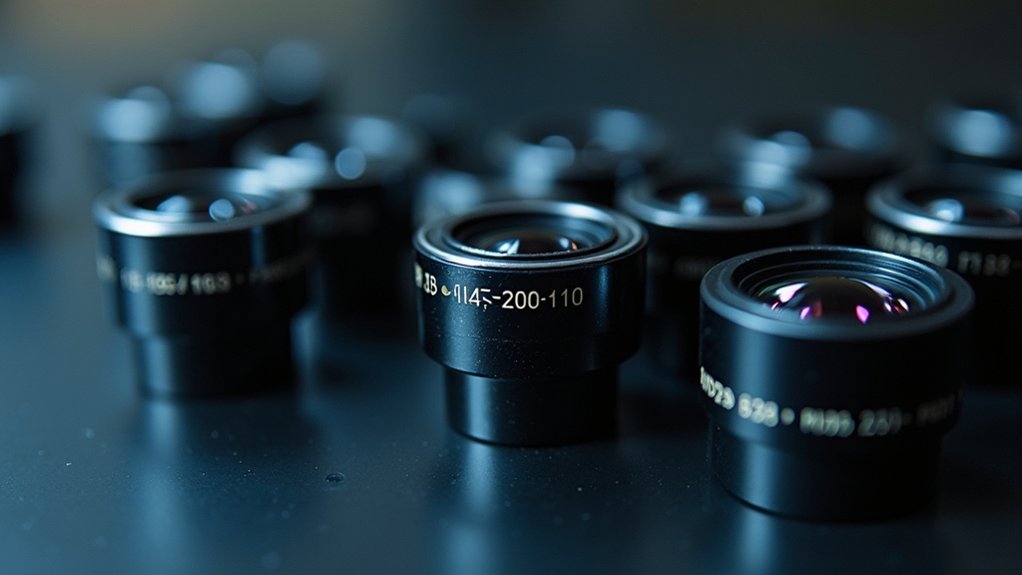
When selecting microscope objectives for scientific photography, you’ll encounter two fundamental classifications that determine their compatibility with your imaging system. Infinity objectives require an infinity tube for mounting, while finite objectives must be positioned at a specified distance from your image sensor.
The numerical aperture (NA) of your objective lens is essential for image quality—higher NA values deliver superior resolution and light-gathering capability. However, this typically comes with a trade-off in working distance, which shortens as magnification increases.
For applications requiring more space between the lens and specimen, consider specialized ELWD or SLWD objective lenses.
Don’t overlook coating specifications—anti-reflective coatings greatly enhance light transmission and reduce unwanted reflections, ensuring your scientific images capture the finest details with precision.
Key Features to Consider When Selecting Microscope Objectives
When selecting a microscope objective for your scientific photography, you’ll need to prioritize numerical aperture (NA) since higher values directly correlate with better resolution and light-gathering ability.
You’ll face important tradeoffs with working distance, as objectives with higher magnification and NA typically offer shorter working distances, limiting your flexibility with thicker specimens.
Consider your specific application requirements carefully, as the ideal balance between numerical aperture and working distance will determine both your imaging capabilities and practical workflow efficiency.
Numerical Aperture Matters
Resolution, the holy grail of scientific photography, hinges critically on numerical aperture (NA). When selecting objective lenses, you’ll find NA values directly impact your image quality more than magnification alone. Higher NA values capture finer details but reduce depth of field.
| Objective Type | Typical NA | Resolution (550nm light) |
|---|---|---|
| Air (40x) | 0.65-0.95 | 290-226 nm |
| Water (60x) | 1.0-1.2 | 225-196 nm |
| Oil (100x) | 1.3-1.5 | 177-157 nm |
| Specialized | 1.5-1.7 | 157-134 nm |
| Future Tech | >1.7 | <134 nm |
Working Distance Tradeoffs
Although often overlooked in favor of magnification and resolution, working distance represents a critical factor in objective lens selection.
You’ll find that as magnification and numerical aperture increase, working distance typically decreases—a fundamental tradeoff you must contemplate for your application.
When you need more space for specimen manipulation or lighting, consider ELWD objectives. They provide the clearance you need, though often at higher cost and potentially reduced optical performance compared to standard objectives.
Different applications demand different working distances. Industrial inspections require sufficient space for tools and lighting, while high-resolution imaging may necessitate closer proximity.
For example, a 20X objective might offer 0.400 mm working distance, while a 50X provides 0.670 mm.
Balancing these tradeoffs guarantees you’ll select objectives that deliver both the resolution and accessibility your work requires.
Comparing Achromatic vs. Plan vs. Apochromatic Lenses for Image Quality
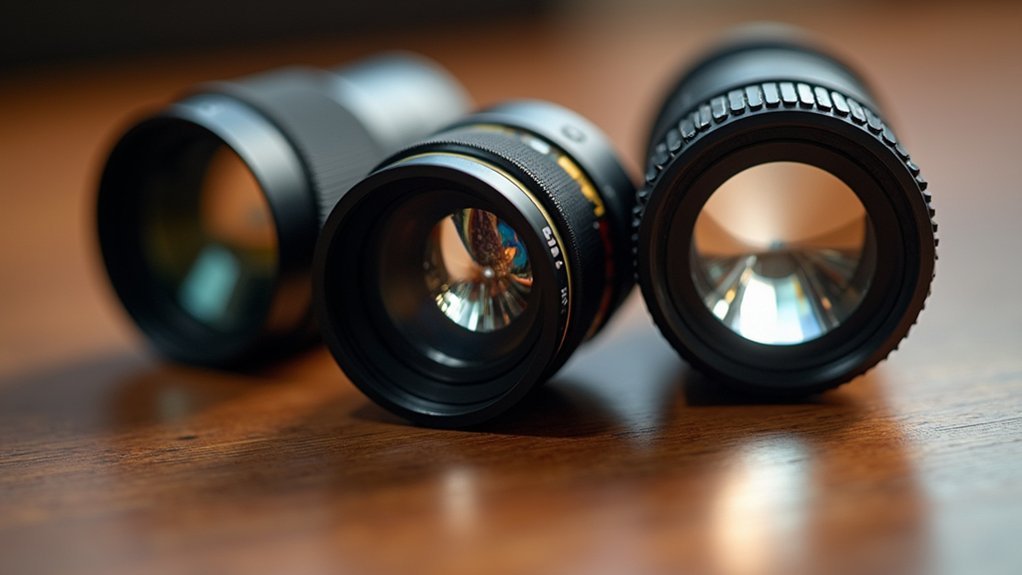
When choosing the best lens for your scientific photography, you’ll need to balance Plan lenses’ superior field flatness against Apochromatic lenses’ exceptional color correction capabilities.
Achromatic lenses provide a cost-effective option with approximately 60% field of view, while Plan lenses deliver 100% field flatness with minimal distortion across the entire image.
Your decision should ultimately reflect your specific imaging requirements, weighing performance factors against budget constraints to achieve the ideal value-performance ratio for your research needs.
Field Flatness Comparison
Three primary types of objective lenses differentiate themselves dramatically when examining field flatness, a critical factor for scientific photography.
Achromatic lenses deliver approximately 60% field flatness, resulting in noticeable edge distortion that can compromise precision imaging.
Plan lenses represent the gold standard with 100% field flatness, providing uniform brightness and sharpness across your entire field of view. You’ll find these ideal for applications requiring consistent detail throughout the image.
Though Apochromatic lenses aren’t always explicitly rated for field flatness, they typically surpass achromats in overall image clarity and color correction.
The discontinued Semi-Plan lenses (80% flatness) fell short of Plan quality.
Your choice ultimately depends on specific needs—Plan lenses excel for general scientific photography, while Apochromatic lenses shine when superior color performance is paramount.
Color Correction Capabilities
Despite their widespread use, different objective lenses exhibit substantial variations in color correction that directly impact scientific image quality. When selecting your imaging system, understanding these differences becomes critical for achieving accurate results.
Achromatic lenses correct for two wavelengths but leave visible color fringing that can compromise precision in your measurements.
Plan lenses offer improved performance with flat-field imaging and better overall color uniformity across your entire sample.
For superior scientific imaging:
- Apochromatic lenses deliver exceptional color fidelity by correcting aberrations across three wavelengths (red, green, and blue)
- Higher numerical aperture apochromatic objectives provide unmatched contrast and resolution for detailed structures
- Semi-apochromatic options (like Leica’s with ≤2.5x depth of field focus difference) offer practical balance between performance and cost
The choice directly affects your data’s reliability and reproducibility in high-resolution applications.
Value-Performance Ratio
While color correction capabilities establish optical performance benchmarks, your research budget ultimately demands a practical evaluation of value-to-performance ratios among objective lens options.
Achromat lenses offer solid value with approximately 60% field of view, making them suitable for routine imaging tasks. However, if you require complete field coverage, Plan lenses deliver 100% field of view with superior brightness uniformity—though at a higher price point.
For specialized applications demanding precise color accuracy, Apochromatic lenses justify their premium cost through superior chromatic aberration correction and enhanced image sharpness.
Consider also that ASC lenses provide better contrast than standard Achromats at competitive prices.
Remember to evaluate numerical aperture when comparing options—higher-end lenses typically feature greater NA values, improving your ability to capture fine details essential for scientific documentation.
The Impact of Numerical Aperture on Resolution and Light Gathering
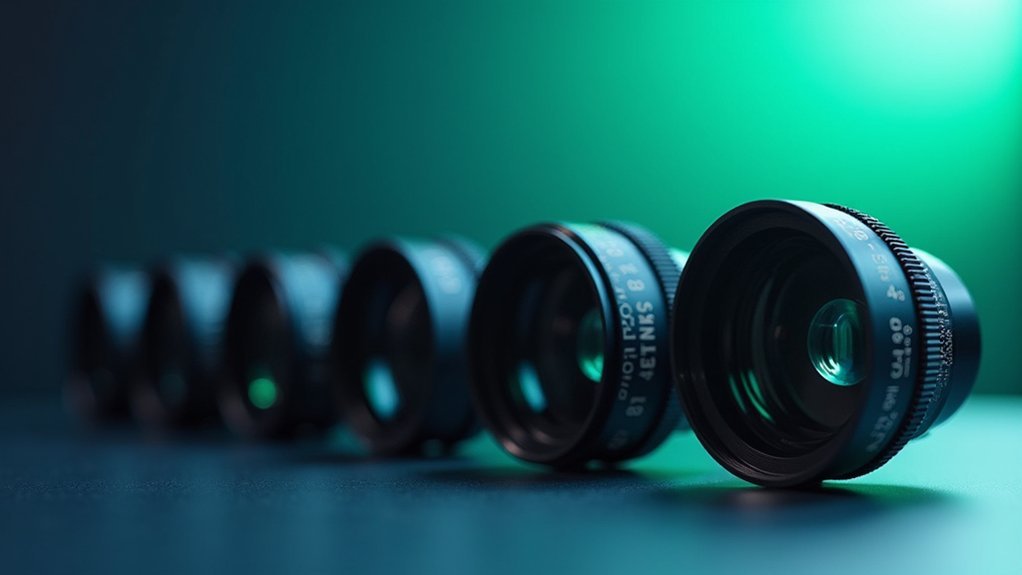
When selecting objective lenses for scientific photography, understanding Numerical Aperture (NA) becomes essential as it directly determines your imaging capabilities.
Higher NA values (especially above 1.0 in oil immersion lenses) dramatically enhance your resolution, allowing you to capture details as small as 196 nm using a 550 nm light source.
- Imagine viewing previously invisible cellular structures suddenly appearing crisp and defined as you switch to a high-NA objective.
- Picture the striking contrast between a standard lens’s hazy image and the brilliant clarity of an oil immersion lens with NA>1.3.
- Visualize focusing through an increasingly narrow depth of field as you pursue the finest details in your specimen.
Working Distance and Field of View: Critical Factors for Scientific Photography
As you explore deeper into scientific photography, two parameters become increasingly vital beyond just numerical aperture: working distance and field of view.
You’ll notice that higher magnification objectives like the i-PlanAPO-HRNIR-50X offer impressive resolution (4.00 µm) but come with shorter working distances (0.670 mm), potentially limiting your ability to photograph without interference.
Field of view varies considerably across objective types, with Plan lenses delivering 100% FOV—ensuring uniform brightness throughout your entire image. This becomes essential when capturing detailed scientific specimens where edge clarity matters.
Remember that working distance decreases as magnification and numerical aperture increase. For specialized applications, consider metallurgical objectives that provide tailored working distances designed specifically for high-resolution imaging.
Understanding these relationships helps you select the best lens for your specific research needs.
Specialized Objectives for Specific Research Applications
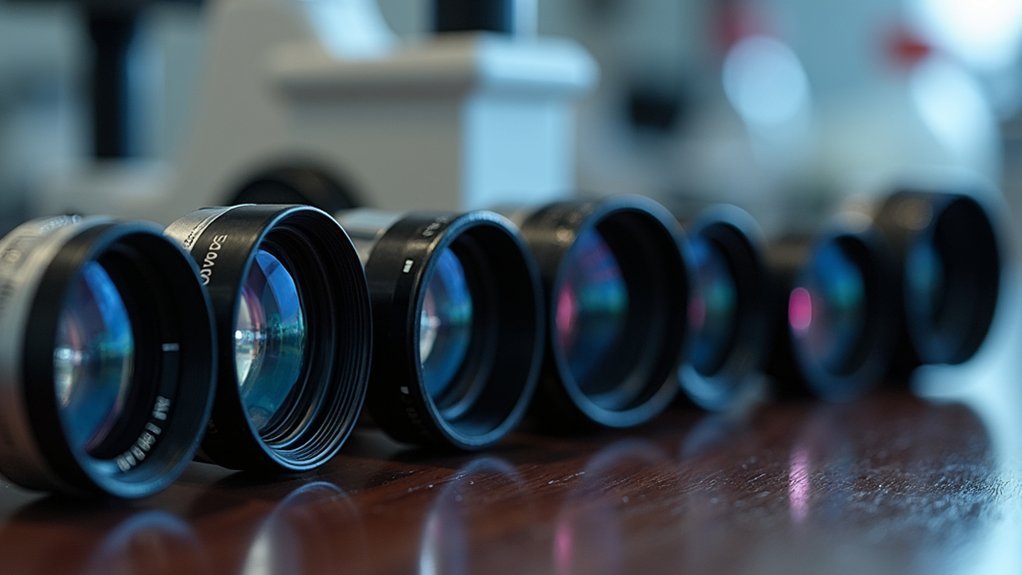
The scientific imaging landscape expands beyond general-purpose lenses into highly specialized territory. When your research demands exceptional precision, you’ll need objectives tailored to specific applications.
Specialized scientific objectives deliver precision imaging beyond standard lenses, transforming research capabilities for demanding applications.
Metallurgical objectives excel with opaque specimens at 20:1+ magnifications, while fluorite objectives deliver enhanced color correction and UV transmission for high-resolution tasks requiring ideal clarity.
For the most demanding applications, consider:
- Apochromats with their maximum correction across multiple wavelengths, minimizing aberrations for pristine research imaging
- Infinity objectives like Nikon’s CFI Plan series with superior numerical aperture for enhanced resolution
- Objectives with specialized coatings that greatly reduce reflections and improve contrast for transparent specimens
Your choice of specialized objective will greatly impact your imaging results, making selection based on your specific research requirements essential.
Adapting Microscope Objectives for DSLR and Mirrorless Camera Systems
Four critical components enable successful adaptation of microscope objectives to modern camera systems.
First, proper alignment between the objective and your camera’s sensor plane is essential, as finite objectives require specific distances to maintain ideal performance.
Second, consider the numerical aperture (NA) of your chosen objective. Higher NA values deliver superior light-gathering capabilities and resolution—critical for capturing microscopic details with precision.
Third, specialized adapters that maintain the correct optical path length are necessary to preserve the objective’s designed working distance and focal properties.
Finally, remember that microscope optics operate at fixed apertures. Understanding the effective f-stop will help you avoid diffraction issues at high magnifications.
When properly implemented, these adaptations yield considerably sharper images than traditional macro lenses, making them invaluable for scientific photography requiring extreme detail.
Cost-Benefit Analysis: Budget-Friendly vs. Premium Objective Options
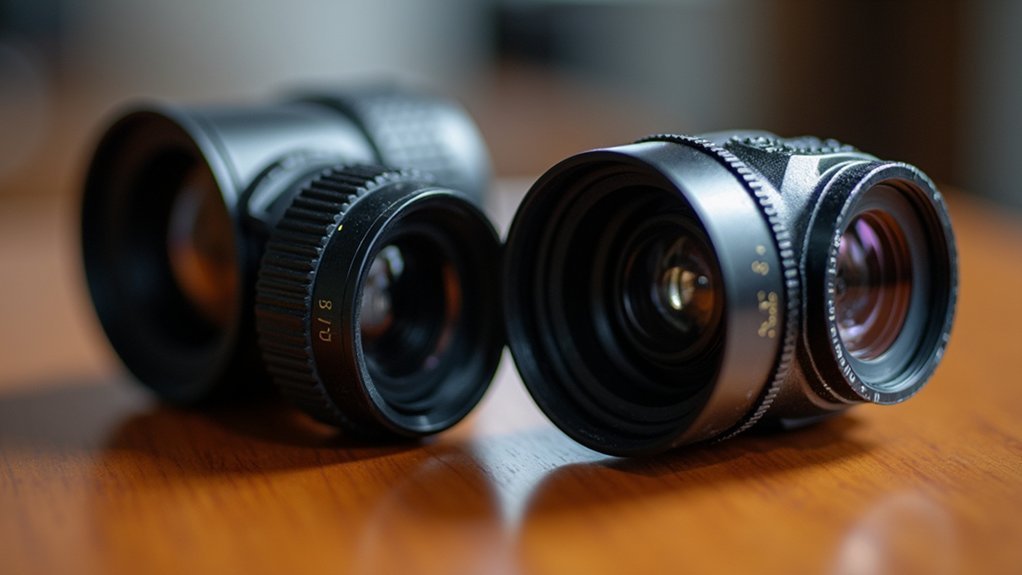
When selecting an objective lens for scientific photography, understanding the cost-benefit relationship between budget-friendly and premium options becomes essential for maximizing your investment.
Achromat objectives offer good value with 60% field of view, while ASC lenses provide enhanced contrast and sharper images at a modest price increase.
- Achromats serve as entry-level optical equipment for those on tight budgets, though you’ll notice limitations in numerical aperture and edge clarity.
- ASC objectives strike an ideal balance—delivering superior contrast and image quality without the premium price tag of high-end alternatives.
- Plan lenses represent the premium tier with 100% field of view and exceptional brightness uniformity, justifying their cost for specialized applications.
For professional-grade results, consider Leica’s Apochromats, despite their higher price point.
Frequently Asked Questions
What Is the Most Powerful Objective Lens?
The most powerful objective lens you’ll find is an apochromat with a numerical aperture exceeding 1.4. You can achieve magnifications of 100x or higher with these lenses for maximum optical performance.
What Are the Objective Lenses 4x, 10X, 40X, and 100X Used During?
You’ll use 4x for initial scanning, 10x for moderate views of larger structures, 40x for detailed cellular examinations, and 100x (with oil immersion) for observing extremely fine details of microorganisms.
Which Objective Lens Will Give You the Greatest Resolving Power?
You’ll get the greatest resolving power from a 100x oil immersion objective with high numerical aperture (NA). These apochromat lenses, especially with values of 1.4 NA or higher, resolve details down to 200 nm.
What Is the 100X Objective Lens Used For?
You’ll use the 100x objective lens for high-resolution imaging of minute structures like cellular organelles and bacteria. It’s ideal when you need exceptional detail in biological specimens or materials science applications.
In Summary
You’ve now got the knowledge to select the perfect objective lens for your scientific imaging needs. Remember to weigh numerical aperture against working distance, and consider your specific applications before investing. Whether you choose achromatic lenses for routine work or apochromatics for publication-quality images, the right objective will dramatically enhance your research results and visual documentation capabilities.





Leave a Reply